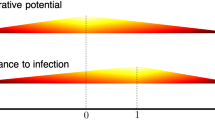Abstract
This paper presents a model of the co-evolution of transmissible disease and a population of non-randomly mixed susceptible agents. The presence of the disease elements is shown to prevent the onset of genetic convergence of the agent population. The epidemiological model also acts in a distributed fashion to counter the tendency of the agent population to occupy spatially close-knit communities. The simulation applies a modified mathematical SIR epidemiological model of disease transmission in combination with the well-studied technique of artificial ecosystems. It includes various aspects of disease transmission that are not usually modelled due to the effort required to incorporate them into mathematical models. These include a distributed agent population with non-uniform infectiousness and immunity as well as a mutable disease model with evolving latency and infections that evolve to prey on diverse agent characteristics.
Access this chapter
Tax calculation will be finalised at checkout
Purchases are for personal use only
Preview
Unable to display preview. Download preview PDF.
Similar content being viewed by others
References
Dorin, A.: The Virtual Ecosystem as Generative Electronic Art. In: 2nd European Workshop on Evolutionary Music and Art, Applications of Evolutionary Computing: EvoWorkshops 2004, Coimbra, Portugal, pp. 467–476. Springer, Heidelberg (2004)
Yaeger, L.: Computational Genetics, Physiology, Metabolism, Neural Systems, Learning, Vision and Behavior or Polyworld: Life in a New Context. In: Artificial Life III, pp. 263–298. Addison-Wesley, Reading (1992)
Todd, P.M.: Artificial Death. Jahresing 41, 90–107 (1994) (German modern art yearbook)
Mascaro, S., Korb, K.B., Nicholson, A.E.: Suicide as an Evolutionary Stable Strategy. In: Kelemen, J., Sosík, P. (eds.) ECAL 2001. LNCS (LNAI), vol. 2159, pp. 120–133. Springer, Heidelberg (2001)
Ray, T.S.: An Approach to the Synthesis of Life. In: Artificial Life II, Santa Fe, New Mexico, pp. 371–408. Addison Wesley, Reading (1990)
Cartlidge, J., Bullock, S.: Caring Versus Sharing: How to Maintain Engagement and Diversity in Coevolving Populations. In: Banzhaf, W., Ziegler, J., Christaller, T., Dittrich, P., Kim, J.T. (eds.) ECAL 2003. LNCS (LNAI), vol. 2801, pp. 299–308. Springer, Heidelberg (2003)
Hillis, W.D.: Co-Evolving Parasites Improve Simulated Evolution as an Optimization Procedure. In: Artificial Life II, Santa Fe, New Mexico, pp. 313–324. Addison-Wesley, Reading (1990)
Ackerman, E., Elvebeck, L.R., Fox, J.P.: Simulation of Infectious Disease Epidemics. Charles C Thomas Springfield, Illinois (1984)
Bailey, N.T.J.: The Mathematical Theory of Infectious Diseases and Its Applications, vol. 2. Charles Griffin & Company, London (1975)
Durrett, R., Levin, S.: The Importance of Being Discrete (and Spatial). Theoretical Population Biology 46(3), 363–394 (1994)
Willox, R., Grammaticos, B., Carstea, A.S., Ramani, A.: Epidemic Dynamics: Discrete-Time and Cellular Automaton Models. Physica A 328, 13–22 (2003)
Martins, M.L., Ceotto, G., Alves, S.G., Bufon, C.C.B., Silva, J.M., Laranjeira, F.F.: A Cellular Automata Model for Citrus Variagated Chlorosis 10 (2000) eprint arXiv: cond-mat/0008203
Pilot Projects for Models of Infectious Disease Agent Study (Midas). Webpage. National Institute of General Medical Sciences (NIGMS) (Accessed: October 2004), http://grants.nih.gov/grants/guide/rfa-files/RFA-GM-03-008.html
Kermack, W.O., McKendrick, A.G.: Contributions to the Mathematical Theory of Epidemics. Proceedings of the Royal Society, London 115, 700–721 (1927)
Dorin, A.: Artificial Life, Death and Epidemics in Evolutionary, Generative Electronic Art. In: Rothlauf, F. (ed.) EvoWorkshops 2005. LNCS, vol. 3449, pp. 448–457. Springer, Heidelberg (2005)
Author information
Authors and Affiliations
Editor information
Editors and Affiliations
Rights and permissions
Copyright information
© 2005 Springer-Verlag Berlin Heidelberg
About this paper
Cite this paper
Dorin, A. (2005). A Co-evolutionary Epidemiological Model for Artificial Life and Death. In: Capcarrère, M.S., Freitas, A.A., Bentley, P.J., Johnson, C.G., Timmis, J. (eds) Advances in Artificial Life. ECAL 2005. Lecture Notes in Computer Science(), vol 3630. Springer, Berlin, Heidelberg. https://doi.org/10.1007/11553090_78
Download citation
DOI: https://doi.org/10.1007/11553090_78
Publisher Name: Springer, Berlin, Heidelberg
Print ISBN: 978-3-540-28848-0
Online ISBN: 978-3-540-31816-3
eBook Packages: Computer ScienceComputer Science (R0)




